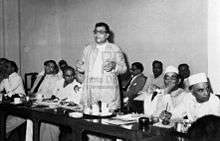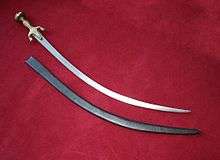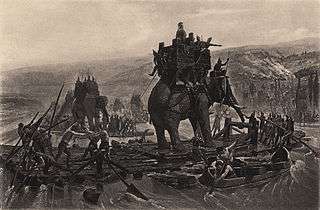Khandayat
Khandayat (from Sanskrit khandâ-âyata, "master of the sword") is a caste of Odisha in India. Khandayats are one of the largest and were the highest caste of Odisha throughout its medieval history except for last century where Brahmins dominated caste in Orissa, constituting around 18% of the state's population. Khandayats were mainly involved in ruling and operating the body of society in ancient to medieval era. After Turkic-Mongol invasion of Northern India, when warrior clans and societies had almost lost their power and dominance, Khandayats in Odisha were still prosperous politically and did much to protect the land of Odisha free from foreign incursions.[1] They are a regional sub-caste of the warrior caste such as Rajputs or Khatris, and are mainly concentrated in Odisha.[2]
| Khandayat | |||
|---|---|---|---|
| |||
| Varna | Kshatriya | ||
| Religions | Hinduism | ||
| Languages | Odia | ||
| Populated States | Odisha | ||
Etymology

The name Khandayat is originated from the term "Khandâ" with its origin in Sanskrit which means the sword and "âyata" means control in specific area. So according to the order of Shree Gajapati Maharaja, literally Khandayat means a person having complete control over rules, warfare, and discipline.[3][4]
History

Traditionally they are martial caste or people belonging to the warrior class also known as "Kshatriyas".[5][6] The Khandayats have a recorded history of over 2500 years, and have been noted in historical events such as the famous Kalinga War and the Paik Rebellion, where, along with the East Indian Company Khonds regiment, they fought strenuously against British Rule. The Khandayats are supposed to have ruled Odisha and several adjoining parts in 16th century with the death of last Gajapati emperor Mukunda Dev, who was killed by Govinda Vidyadhara in 1541. Govinda Vidyadhara was the founder of Bhoi (Bhoumyokar) dynasty in Orissa. Since then, the ruling families such as Singh Deo, Bhanj Deo, Singha Deb are limited to their rule in Odisha. The advent of land holding came as a central issue for Khandayats in the medieval ages, as feudalism became an important factor in the common Indian society. Hence, after each battle or war, Khandayats who had fought were given lands or "jagirs" according to their rank and success in the battlefield. Because of this, by the end of 19th century, most landholdings became part and parcel of people from the Khandayat community. However, with all of Odisha and India coming under East India Company's rule, land was minutely distributed among people of other castes such as Brahmin and Karana, so as to not make Khandayat the only dominant force, politically, in Odisha.[3]

By the mid 20th century Khandayats (particularly the Zamindari class) were at a complete loss when Zamindari system was removed forcibly by the Indian Republican Constitution and government took the possession of their extra lands in Independent India. Though this action irrevocably destroyed feudalism and the land backbone for Khandayat community, however, secular education became a greater issue for the upper castes.[3] Khandayats, like Brahmins of Odisha, asserted their power of civil education by producing educators, civil officers, and astute politicians not just after Indian independence, but also prior in British era.[7]
Present day

Due to removal of feudalism and end of royalty in Republic India, Khandayats had to divert their interests in secular fields. With the assist of secular education passed through the British Education system in India, Khandayats could easily strive in areas of higher education, civil service, industries, and politics.[7] Earlier, they were concentrated in the coastal districts like Cuttack, Kendrapara, Khurda, Puri, Ganjam, Jagatsinghpur, Jajpur, Nayagarh, Bhadrak, Baleswar, Dhenkanal,Sambalpur with some pockets in central Orissa. However, this has changed over the years due to increased movement of people within the state as a result of greater industrialization and focus on cities.
Subdivisions
Khandayats are divided into various clans under the common division of the Khandayat jāti. The four are listed as Agnivanshi, Suryanvanshi, Nagavanshi and Chandravanshi. It is considered that Khandayats are one homogeneous community, however this community is divided into various class strata along with the a fore-mentioned clans. But these divisions are of a social nature and has no effect on religious customs or rituals. At the first are Rajputia Khandayats, which consists of the erstwhile royal families, next is Sresth-Khandayats, who are generally people related to the royal family or people whose forefathers' actions have been of noteworthy to the kingdoms in the medieval ages, and then the normal Khandayats, who are traditionally warriors, and at peacetime, educators, agriculturalists, and distinguished leaders of towns and villages.[8]
Customs
They strictly adhere to North Indian Brahminical customs and rituals and used to be very caste conscious in regards to marriage. However, as social reforms are being brought about, intercaste marriage not just amongst the community but also the various communities in Odisha are taking place. Also, marriage is followed according to determination of one's Gotra/lineage and Kundali/horoscope. Common Gotras are Bhardawaj, Gautama, Kashyap, Vasistha, Bachasya, Ballabhadra or Nageshya. Though marriage within the caste was the norm, however sa-gotra (trans. within's one clan/lineage) is generally forbidden.[9]
Surnames
Titles and surnames include Biswal, Dhal, Nayak, Gadanayak, Indrasingh, Mishra, Khuntia, Swain, Pal, Bishoyi, Dalai, Patro, Jena, Samal, Baral, Nanda, Acharya, Rout, Mahatab, Routaray, Paikaray, Singhdeo, BhanjDeo, Kanungo, Sundaray, Deo, Dhir, Mohanty, Sahu, Maharathi, Singh, Sinha, Pradhan, Samantaray, Samanta, Parida, Khandayatray, Bakshi-rai, Ray, Chhotray, Dalasinghray, Srichandanray, Champatiray, Choudhary, Behura, Muduli, and Mahapatra.[9]
Paika Akhada

Paika means fighter or warrior in Odia language. Paika Akhada is a place where the Paikas were getting their military training. During medieval times, infantry units, also called padatika (infantry), would be recruited from various communities in Odisha. These units would be trained into various military skillsets by an officer/leader given the title of Paik, who lead them to engage in various expeditions for the protection of their kingdom.[10] The Paikas were Khandayats, who had tremendous control over swords.[5][4][11]
See also
- List of Khandayats
- Routaray, a warrior Brahmin subclass of Khandayat found in Odisha
- List of Khandayat dynasties and states
References
- ↑ Pati, Biswamoy (2001). "Situating Social History: Orissa 1800 - 1977". Google Books. Retrieved 10 September 2016.
- ↑ Patnaik, N (2000). "Sacred Complex in Orissa". Google Books. Retrieved 20 September 2016.
- 1 2 3 Ernst, Waltraun; Pati, Biswamoy (2007). "India's Princely States: People, Princes and Colonialism". Google Books. Retrieved 13 September 2016.
- 1 2 Indian Association of Kickboxing Organisations, 9 February 2013. "Paika Akhada".
- 1 2 Mohapatra, Dr. Hemanta Kumar (December 2014). "Martial Art Tradition of Odisha" (PDF). OdishaReview - Govt. of Odisha. OdishaReview - Govt. of Odisha. Retrieved 16 December 2015.
- ↑ Bailey, Frederick George (1970). Politics and Social Change. University of California Press. p. 132.
- 1 2 Grover, Verinder (1999). "Political System in India: Politics of influence, violence and pressure groups". Deep & Deep. Retrieved 12 September 2016.
- ↑ Samal, KD (2006). "Economic History of Orissa, 1866-1912". Mittal Publication. Retrieved 7 August 2016.
- 1 2 Berger, Peter (2015). "Feeding, Sharing, and Devouring: Ritual and Society in Highland Odisha, India". De Grutyer. Retrieved 29 August 2016.
- ↑ Patnaik, N (2000). "Sacred Complex in Orissa: Study of Three Major Aspects of the Sacred Complex". G. Publishing House. Retrieved 9 September 2016.
- ↑ Eaton, Richard Maxwell (2015). "The Sufis of Bijapur, 1300-1700: Social Roles of Sufis in Medieval India". Princeton University Press. Retrieved 8 September 2016.
Further reading
- Ernst, Waltraud; Pati, Biswamoy, eds. (2007). India's Princely States: People, Princes and Colonialism. Routledge. ISBN 978-1-13411-988-2.
- Pati, Biswamoy (2001). Situating Social History: Orissa, 1800-1997. Orient Blackswan. ISBN 978-8-12502-007-3.
- Senapati, Fakir Mohan (2005). Six Acres and a Third: The Classic Nineteenth-century Novel about Colonial India. Mishra, Rabi Shankar (trans.). University of California Press. ISBN 978-0-52022-883-2.
- Roy, Bhaskar (2004). "Khandayats moving into political gear in Orissa". Times of India.
